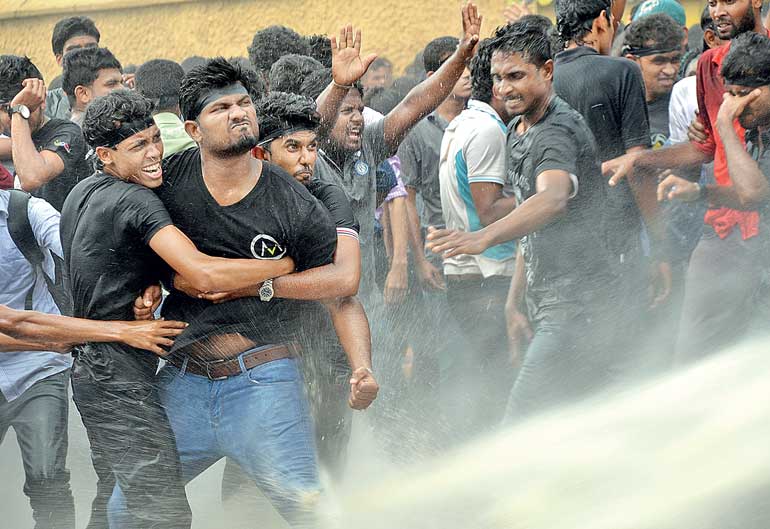Sunday Apr 06, 2025
Sunday Apr 06, 2025
Wednesday, 4 November 2015 00:15 - - {{hitsCtrl.values.hits}}

The HND accountancy drama a few days back is a manifestation indeed of education policy making at its silo worst
- Pic by Shehan Gunasekara
The Higher National Diploma or HND in Accountancy problem is a storm in a teacup made into a national drama by incompetency all around. Protesting HND students had their usual free education slogans, but all they wanted was a reinstating of Public Administration Ministry Circular 46/1990 which considered HNDs as equivalent to a B.Com. degree for recruitment and promotion purposes in the public sector. 
The previous Government tried to bring the HND qualifications offered by the Sri Lanka Institute for Advanced Technical Education (SLIATE) within its mandated mission. SLIATE was created in 1995 to foster advanced technical education through the awarding of diplomas and higher diplomas. For some reason, historical perhaps, SLIATE drags on its HND programs for three to four years of fulltime study when the international practice is the awarding of an HND after two years.
Rolling back the HND is no longer politically viable. If the future is in an inflation of qualifications, we might as well do it properly. In that regard, it is well and good that the Government is looking at a national qualification framework as the basis. The present Sri Lanka Qualifications Framework (SLQF) is a misnomer. It is a qualification framework created by academics for academics. It is not even a good Higher Education Qualification Framework (HEQF) as I elaborate later.
Sri Lanka is education silo capital
Sri Lanka has a uniquely rigid and compartmentalised policymaking structure in comparisons to its Commonwealth or other neighbours. We have separate ministries for school education, university education and vocational education and training, with little communication among the three. In effect, a ‘silo’ structure that prevents coherent and effective policy making is in place here.
In contrast, the education sectors in other countries in the commonwealth, such as Australia, Hong Kong, India, Malaysia, Indonesia, Singapore and UK, are led by a single ministry for education and supported by departments, authorities or commissions dedicated to different sectors and/or different functions.
This structural difference is manifested in the gap between promise of free-of-charge education and its delivery in the education sector in Sri Lanka. The HND accountancy drama a few days back is a manifestation indeed of education policy making at its silo worst.
Higher education silo
The z-score admission system has created a watertight system that rigidly controls admission from out of the silo to in. But, leakages from in-to-out are becoming apparent. In Humanities and Social Science faculties, young men have voted with their feet. The result is a student body made up of 85% of more women. Monks make up a highly visible part of the fraction of males in those faculties. No shows are becoming common in science faculties, and, even after registering, lectures are not taken seriously. Since higher education is a free of charge, whatever the quality, there will always be takers.
The silo problem is the reason for lack of success in higher education reforms, I believe. Large amounts of money have been spent on ‘within-silo’ reforms when the need is for winds of change from outside. Quality assurance processes where weak evaluated weak and the development of a qualification framework which does not sync with international norms or local development are cases in point.
Worse still, this higher education silo affects matters outside. For example, academics from the university lead institutes of education and chair important curricular committees etc. in school education, propagating insularity and mediocrity from top to bottom in the education sector in Sri Lanka. It is a pity that Government continues to look to mouldy higher education silos for resources without looking outside, locally, or even internationally from among qualified expatriates.
Alternative higher education silo
All HND programs offered by the Government are under the purview of SLIATE which is identified as the agency responsible for the alternative higher education sector. In a rush to create alternate opportunities for those who cannot be accommodated within the limited capacity of universities, policymakers have inadvertently created a sub class of students within higher education. The fact that our universities are rigidly structured with no room for lateral entry or exit makes the alternative education sector a ‘silo that traps’ students and the apparently authentic higher education silo a ‘silo that excludes’.
To add ‘injury to insult’, the HND accountancy curriculum at ATIs, for example, requires 128+ credit hours of work spanning over four years when a management degree with accounting specialisation can be completed at a public university with 128 credit hours and the same duration.
Technical and vocational silo
A third silo, in regard to transferability across public sector institutions includes technical and vocational training institutes under the purview of Tertiary and vocational Education Commission (TVEC). Although the sector has achieved much in regard upward mobility and lateral transfers within the sector thanks to a National Vocational Qualification framework in force since 2002, there is not much interaction between the TVET sector and the other two sectors. In fact the so-called SLQF published by the UGC is not sync with the more established NVQ framework and its numbering system.
The real world
Meanwhile, a private sector led by chartered professional institutes and private universities is offering flexibility and transferability which characterises a truly free education. Take the case of accounting education. According to a LIRNEasia survey, enrolments in the three major accounting bodies – Institute of Chartered Accountant of Sri Lanka (ICASL), Chartered Institute of Management Accountants (CIMA) and Association of Accounting Technicians of Sri Lanka (AATSL) – totalled more than 100,000 students in 2011. AATSL is a particularly noteworthy organisation dedicated to vocational training but committed to ensuring multiple pathways of progression, academic or professional progression, for their trainees through MOUs signed with a multitude of organisations.
A national qualification framework is a mechanism for connecting segregated systems of qualifications, but, Sri Lanka is yet to develop a truly national qualification frameworks. The National Vocational Qualifications (NVQ) framework which was introduced by TVEC in 2002 follows the Australian and New Zealand frameworks closely. The NVQ reserves level 1-6 for certificates, diplomas and higher diplomas, and Levels 7-10 for degrees and above.
The qualification framework developed by the Ministry of Higher Education in 2010 with World Bank assistance in contrast is more concerned with distinctions between a general degree and an honours degree or an MA and an MPhil and other university specific concerns. It sets aside levels 5-10 for degree qualifications and above and limits the range for vocational qualifications to Level 1-4!
The six levels from Levels 5-10 which deal with the progression from degree to post-graduate qualification is relevant to less than 10% of a cohort of about 340,000 or more youth who join the ranks of 19-24 year age group every year. It is unfortunate that Sri Lanka does not have a national qualification framework that prioritise the other 90% whose progression from NVQ levels 1-6 and beyond is critical for human resource development in the country.
The education market or the job market has no regard for self-imposed silos found in the public sector. A survey of jobs advertised in the newspapers carried out by LIRNEasia in 2012 revealed job openings in 40+ sectors from Accountancy, Architecture, and Aviation to Logistics, to Teaching and Tourism. Whenever degree level qualifications are sought, equivalent non-degree qualifications too are specified. In some sectors, professional qualifications with or without experience is preferred over degrees. A parallel survey of educational opportunities advertised by private sector in 2012 revealed the existence of 600+ education and training programs offered by 200+ plus institutions.
Unfortunately, our from viewing tertiary education sector from the vantage point of employers or 340,000 youth who join the demographic group of 19-24 year olds every year.
One qualifications authority
Even though our education sector is split across four ministries or more, it is still possible to establish one single qualifications authority to develop and enforce standards for qualifications from GEC (O/L) to diplomas, higher diplomas or professional charters or academic PHDs, within a truly national qualifications framework. Such a qualifications authority would be responsible for informing and educating students at all levels about the full range of educational opportunities public/private, technical/vocational/professional or academic and facilitating smooth articulation and transfer from one qualification to another.
The Office for Qualifications in UK is an excellent example. Sharing of results of graduate tracer studies too could be made mandatory for all qualification awarding bodies providing market signals to both the awarding bodies and prospective enrolees.
Many providers
If a strong policy framework is made available through one policymaking body served by multiple regulatory bodies and one qualifications authority, provision of education can be taken up by any number of provider institutions, including private universities and colleges, chartered institutes, local authorities, provincial authorities, religious bodies and others to increase opportunities for all concerned. A centralised financial support system would be an essential component that ensures equity in access to economically disadvantaged students.
And a BTech solution
A single examination, the GCE (A/L), decides whether one earns a Bachelor’s degree free of charge or earns a diploma or a higher diploma only, and jumps through hoops later to top-up the diploma to a degree. In a class/caste conscious society, forcing young people into these situations is a recipe for disaster. We need avenues for progression for the 320,000 or so youth in each age cohort who are discriminated into a sub class of citizens in this manner.
Therefore, it is better that all HNDs should be standardised to international norm of completion within two years, but bring in laws to allow SLIATE to gradually convert the currently 3.5 to four years-long education programs to Bachelor of Technology programs. HND students should have the option of exiting with an HND or continuing on to a BTech. University of Vocational Technology which is within the Technical and Vocational silo already offers a BTech, but, the combined time for a HND with Btech to up 6.5 to seven years!
If HND students want to launch a well-reasoned campaign for a BTech option after a two-year HND, and they do that without the invisible hand of the Peratugami Party behind them, God speed, I would say. Financing for the Bachelor of Technology programs is another topic which we will have to postpone for later.